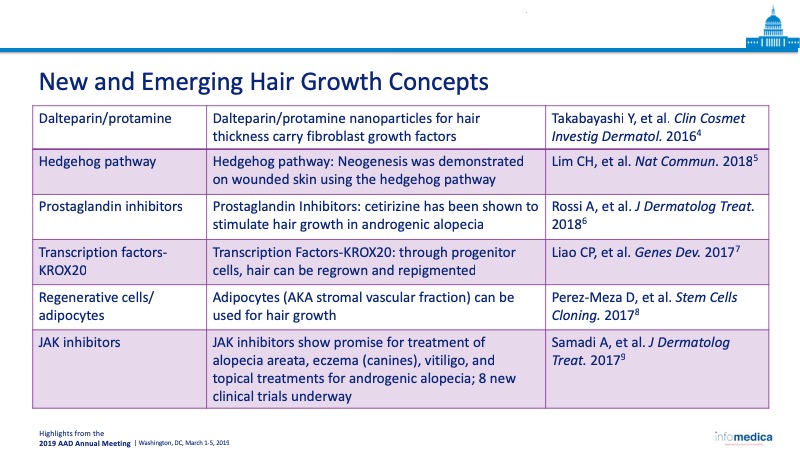Reports
Meeting the Needs of the Hair Challenged Patient
Presented by: Glynis Ablon, MD, FAADAssociate Clinical Professor UCLA, Ablon Skin Institute & Research Center, Manhattan Beach, CA, USA
- Hair loss treatments represent the second largest segment of aesthetic procedures in the United States.
- Hair loss is a prevalent, treatable condition, with many new and emerging treatments for clinicians to offer patients.
- There are multiple potential etiologies for hair loss in males and females, and it is important for clinicians to identify the underlying cause in the individual patient.
More than 70 million Americans suffer from hair loss, 28.6% of whom are female. It is important for clinicians to take the initiative in discussing hair loss treatments with all patients, because despite the high prevalence, most patients incorrectly believe that no hair loss treatments are available, and therefore, do not request medical advice. However, hair loss treatments represent the second largest segment of aesthetic procedures in the United States.
The clinical approach to addressing the patient with hair loss is as follows :
- Determine the type of hair loss and the underlying etiology. Clinicians should take a complete medical history and determine if the patient is on medication linked to hair loss, such as antidepressants, blood pressure medications, anticoagulants, or gout medications. Clinicians should also perform a physical exam and lab work, and further consider a biopsy, Trichoscan, and micro/macrophotography.
- Clinicians should discuss treatment options for the hair loss with patients, discuss prescription medications, start supplements and consider topical growth factors, laser therapy, intralesional corticosteroid injections, and transplant procedures.
- Hair grows from stem cells, in the scalp microenvironment (blood vessels, nerves, adipocytes) impacted by metabolic conditions. Each day, an individual typically looses 100 hairs, and grows 100 new hairs. Hair loss such as androgenic alopecia is polygenic.
- Physicians and researchers can help maintain a healthy and attractive appearance of hair by recommending that patients protect the cuticle, use sunscreen specifically for the hair, avoid harsh chemicals, shampoos, and coloring agents, reduce stress, and improve nutrition through a low glycemic diet.
- The following hair growth treatments are Food and Drug Administration approved : OTC minoxidil, finasteride, dutasteride, platelet rich plasma treatments, spironolactone (combination with minoxidil), low light laser therapy, and transplant procedures. Compounded products include finoxidil and biomimetic peptide. Supplements available for hair growth include nutraceutical supplements with standardized botanical extracts and deep-sea marine protein supplements.
See Table.
Recent scientific research on hair growth pathways includes the following areas [1] :
- Wingless drosophila gene and vertebrate integrated homolog (Wnt) signaling glycoprotein
- MAPK (mitogen activated protein kinases) signaling
- TGF beta signaling
- Signaling between matrix and dermal papilla during hair follicle growth.
Wnt signaling glycoprotein is a pathway in stem renewal, however, there are oncologic risks with chronic Wnt over activation. WAY-316606 is well-tolerated and specific antagonist of SFRP1 to prolong the growth phase of the hair cycle and has been shown to stimulate human hair growth in studies [2,3].
Other new research highlighted the following :
- Dalteparin/protamine nanoparticles for hair thickness carry fibroblast growth factors [4].
- Neogenesis was demonstrated on wounded skin using the hedgehog pathway [5].
- Prostaglandin inhibitors : cetirizine has been shown to stimulate hair growth in androgenic alopecia [6].
- Transcription factors-KROX20 : through progenitor cells, hair can be regrown and repigmented [7].
- Regenerative cells : adipocytes (AKA stromal vascular fraction) can be used for hair growth. Adipocyte lineage cells support the stem cell niche and help drive the complex hair growth cycle. Adipose-derived regenerative cells are a heterogeneous group of noncultured cells that can be extracted from adipose by using automated systems [8].
Eight new alopecia clinical trials are underway examining developments in JAK inhibitors, as they have shown promise for the treatment of alopecia areata, eczema (canines), vitiligo, and topical treatments for androgenic alopecia [9].
Nutraceutical supplements with standardized botanical extracts are emerging for the treatment of hair loss, including ashwanghanda, biocurcumin, and tocotrienosis. Deep-sea marine protein supplements are also available. Clinicians and researchers have found many botanicals effective for the treatment of androgenic alopecia.
- Beta-sitosterol, found in the saw palmetto and in green tea, has been shown to reduce dihydrotestosterone by blocking 5-alpha reductase and effectively treat male pattern hair loss [10].
- Pumpkin seed oil given orally has been shown to reduce 5-alpha reductase and be effective in the treatment of androgenic alopecia [11].
- Melatonin, with anti-inflammatory and antioxidant properties, has demonstrated efficacy in the treatment of androgenic alopecia with topical application [12].
Key Messages/Clinical Perspectives
- The clinician should take the initiative in discussing the topic of hair loss with all patients
- Investigate the cause of hair loss before starting treatment.
- Combination treatments are most effective.
- When treating androgenic alopecia, the use of any modality selected will need to be ongoing.

REFERENCES
Presenter disclosure(s): The presenter has reported relationships with the following company: Honoraria from Galderma Laboratories, L.P.
Written by: Daniel Bennett, MPH
Reviewed by: Martina Lambertini, MD
CONFERENCE SUMMARIES

Welcome to the Highlights from AAD 2019
Prof. Nellie Konnikov, MD, FAADWe are pleased to present highlights from the 2019 Annual Meeting of the American Academy of Dermatology (AAD). Our meeting was held from March 1 to March 5, 2019 in Washington, DC. The AAD conference … [ Read all ]

 amèrica latina
amèrica latina Canada EN
Canada EN Canada FR
Canada FR Deutschland
Deutschland italiano
italiano português
português Taiwan
Taiwan